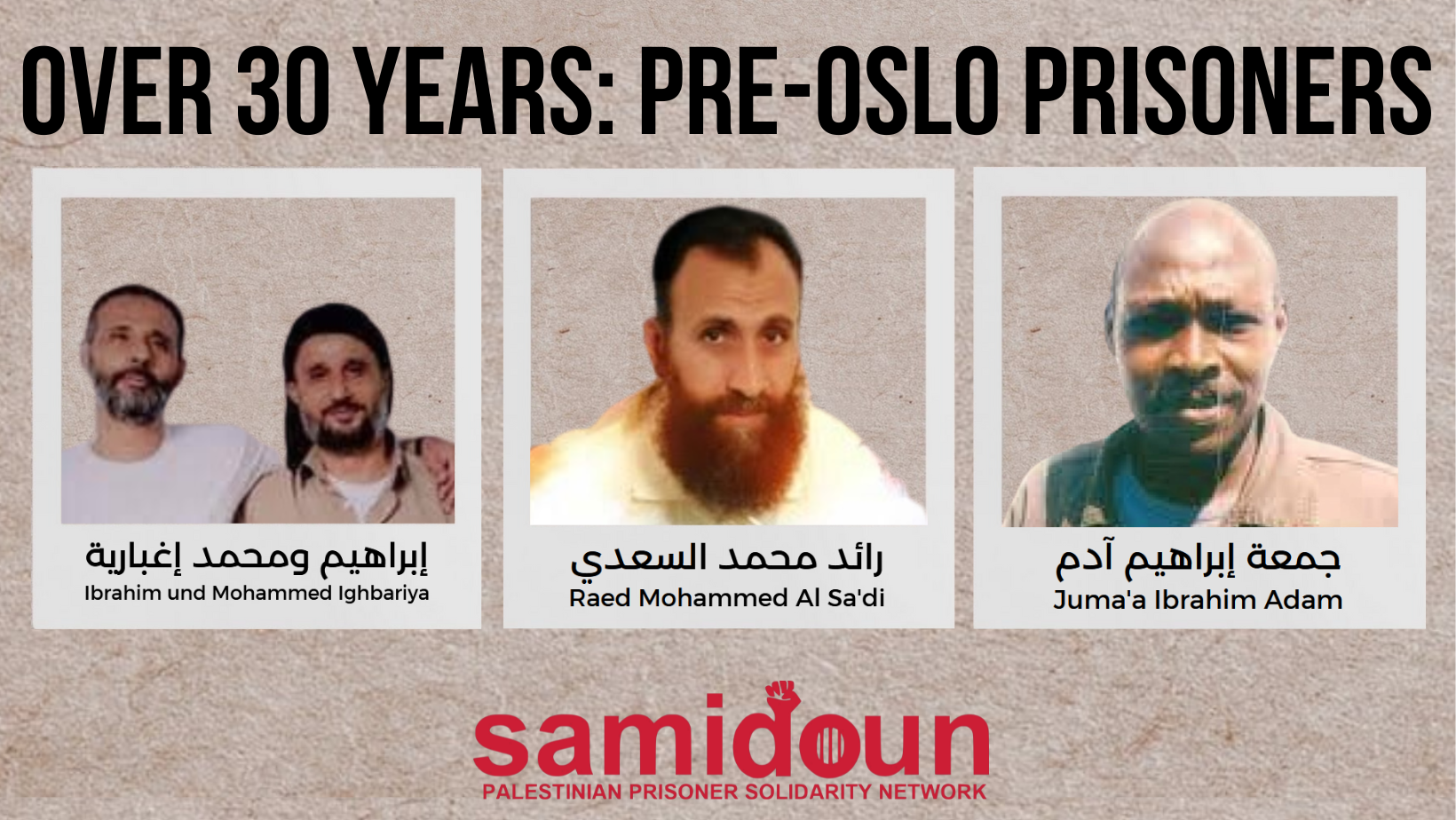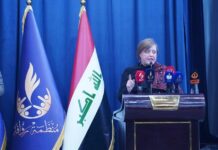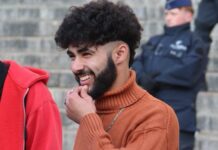
Samidoun Palestinian Prisoner Solidarity Network is providing the materials for the third week of the educational campaign, Over 30 Years: Pre-Oslo Prisoners.
Read the previous two sets of materials:
- Week 3: Mohammed Adel Daoud, Mahmoud Abu Kharabish and Bashir Abdullah al-Khatib
- Week 2: Ibrahim Bayadseh, Ahmad Abu Jaber, Samir Abu Nima
- Week 1: Mohammed Al-Tus, Ibrahim Abu Mokh, Walid Daqqa
This week, we will highlight the Palestinian prisoners: Juma’a Adam, Raed al-Sa’adi and Ibrahim and Mohammed Ighbariya. You can print the posters below, hang them in your cities and communities, and share this link to highlight the struggle of long-held Palestinian prisoners for justice and liberation.
This campaign highlights the “deans of the prisoners,” a term used by Palestinians to describe those who have been held in Israeli occupation jails for over 20 years continuously. Over the years, many Palestinian prisoners were liberated through prisoner exchange deals or other forms of political concession, such as those released in 1995 after the Oslo Accords; the prisoner exchange deal imposed by Hezbollah in 2004 with which 400 Palestinian prisoners were freed; the Wafa al-Ahrar prisoner exchange in 2011, where 1027 Palestinian prisoners were liberated in exchange for the release of the Israeli soldier Gilad Shalit captured by the resistance; or in 2013 when the occupation announced the release of 104 Palestinian prisoners coinciding with the return of the Palestinian Authority to negotiations and the continuation of its security coordination with the occupier under the terms of Oslo and its corollaries.
This campaign aims to ensure that these veteran Palestinian prisoners are not only not forgotten but highlighted and central to the prisoners’ struggle and the Palestinian liberation movement as a whole. Contact us at samidoun@samidoun.net to let us know about actions and events in your area.
Juma’a Ibrahim Adam

Palestinian prisoner Juma’a Ibrahim Adam was born on 9 March 1969 in Sweileh, Jordan, and lived northwest of the city of Jericho, occupied Palestine, in the town of al-Dyouk. He is one of six brothers, and his father died while he was still a young child in 1972. While imprisoned by the Israeli occupation, he lost his mother, and the prison administration did not allow him to see her before her death or to attend her funeral. “The most difficult and painful situation that I went through during my time in prison was the death of my mother,” he said.
He has been repeatedly and systematically denied family visits. His one brother in Palestine has been denied permission to visit him on the basis of “security,” while the rest of his brothers are in exile from Palestine. Within the prison walls, Juma’a has dedicated himself to education, completing high school and undergraduate studies, obtaining a bachelor’s degree from the Hebrew University in political science. He is now studying remotely for a master’s degree in political science, specializing in Israeli affairs, from Al-Quds University.
He recently entered his 35th year in the Zionist occupation prisons, one of the “old prisoners” seized before the Oslo agreement. He was arrested on 31 October 1988 at the age of 19 for participating in the Palestinian resistance, specifically for throwing Molotov cocktails at a bus of occupation soldiers, along with fellow prisoner Mahmoud Abu Kharabish and former prisoner Ahmed al-Takrouri. After this resistance action, which came at the height of the great popular Intifada in occupied Palestine, the occupation army closed all areas of the West Bank and imposed a siege on Jericho, searching the homes of Palestinians house by house. Occupation forces destroyed the homes of the imprisoned resistance fighters, including the Takrouri family home, the home of his uncle Abdel-Rahim Moamen Takrouri, and the home of Juma’a Adam’s grandmother, where he was raised from childhood.
After his arrest and under interrogation, Juma’a and his companions were subjected to severe torture. “We were tortured sadistically and brutally from the moment we were arrested, and we were threatened with murder at the hands of soldiers and interrogators for a period of 70 days in al-Moskobiyeh,” the notorious interrogation center. All this was done to force them to confess to the charges against them. The occupation courts issued a life sentence against them.
He had been arrested previously in December 1986 on charges of throwing stones and Molotov cocktails at occupation soldiers and sentenced to 22 months in occupation prisons. He was released in July 1988 and seized again months later for his role in the resistance. Juma’a Adam is today held in Hadarim prison, and as a result of the long years he has spent behind occupation bars, his health has deteriorated and he suffers from blood disease. He was transferred to the Ramle prison clinic for examinations more than once, and the occupation did not provide him with follow-up or proper treatment.
Raed Mohammad Al-Sa’adi

Palestinian prisoner Raed Mohammed al-Sa’adi was born in Silat al-Harthiyya, west of Jenin, on 20 February 1966, and he is today 57 years old. He is the longest-held prisoner from Jenin governorate. He was arrested for the first time when he was 18 in 1984 and imprisoned for six months for raising the Palestinian flag on the electricity poles in Silat al-Harthiyya.
He lived underground for several years, especially since the beginning of the 1987 Intifada. The occupation arrested his mother and detained her for four months, and then several of his siblings, in order to pressure him to surrender. Finally, disguised occupation soldiers dressed as Palestinians seized him when he went to visit his family home to check on them on 28 August 1989. He was accused of belonging to the Al-Quds Brigades, the military wing of the Islamic Jihad Movement in Palestine and carrying out resistance operations against soldiers and settlers. He was sentenced to two life sentences and 20 years behind bars.
During his years behind bars, he finished high school and obtained a bachelor’s degree and he is currently pursuing his master’s degree. He has been repeatedly denied family visits under the pretext of “security” violations, including one of his brothers who was forbidden visits for 12 consecutive years. He has lost a number of his family members while imprisoned, including his grandmother in 1999, his grandfather in 2001, his uncle Abdullah in 2008, his older brother Imad in 201 and his mother, Hajja Umm Imad in 2014. She was eagerly awaiting her son’s freedom until her last days. Several years ago, his father lost his sight and is no longer able to see.
Al-Sa’adi was supposed to obtain his freedom as part of an agreement with the Palestinian Authority in late 2013, but the occupation reneged on its commitment, releasing three batches of long-term prisoners but not the fourth, including 29 Palestinian prisoners jailed since before Oslo, including al-Sa’adi.
Today, Raed is held in Ramon prison, after he was recently transferred from Gilboa prison. As a result of the lengthy torture he was subjected to and his continuous transfer from one prison to another, he suffers from several diseases, especially heart disease, blood pressure, intestinal disease and stomach ulcers, and he has had several surgeries inside occupation prisons.
Ibrahim and Mohammed Ighbariya

Palestinian prisoners and brothers, Ibrahim Hassan Ighbariya and Mohammed Hassan Ighbariya, are some of the longest-held Palestinian prisoners from occupied Palestine ’48. Ibrahim, known as “Abu Jihad,” is 57 years old, while his brother Mohammed, “Abu Abdullah,” is 55 years old, from Umm al-Fahm. They have been detained since 26 February 1992 and have been sentenced to life imprisonment on charges of carrying out a resistance operation in an occupation military camp that led to the death of three occupation soldiers. They were arrested two weeks later along with fellow prisoner Yahya Ighbariya.
On 28 April 2016, Ibrahim and Mohammed’s father, Hajj Hassan Mahmoud Ighbariya, died at the age of 77. Throughout his life, their father joined all activities in support of the prisoners to call for the release of his sons. He urged their inclusion in all releases and prisoner exchanges negotiated by the Palestinian forces. In 2011, Israeli officials refused to include the brothers in the “Wafa al-Ahrar” prisoner exchange. Like other Palestinian prisoners from occupied Palestine ’48, the occupation refuses to include the brothers in exchanges with the Palestinian resistance, labeling their imprisonment “an Israeli matter,” not a Palestinian matter, because they carry Israeli citizenship. (Despite this frequent excuse used to keep Palestinian prisoners from ’48 behind bars, they face the same conditions of confinement as other Palestinians; now, they face the stripping of their citizenship upon their release, rendering them stateless, part of the fascist assault on the prisoners’ movement.)
Mohammed completed his education inside occupation prisons and obtained a master’s degree in politics and international relations in 2005. He has published many articles and books behind bars, including “Leaders’ Guide to the Art of Leadership,” “The Arabs Inside: Between the Illusion of the Knesset and the Mirage of Equality,” and “Embers in the Darkness of the Prisons.”
Ibrahim proposed marriage and is now engaged to fellow prisoner Mona Qa’adan, from the village of Arraba, Jenin, the sister of Tariq Qa’adan, a leader of the Islamic Jihad Movement in Palestine and a Palestinian prisoner held in Megiddo prison. Mona Qa’adan spent more than 5 years behind bars in Israeli occupation jails on the grounds of her activism and involvement in women’s organizations in the occupied West Bank of Palestine.
The two brothers have been moved from prison to prison on many occasions over the years and are frequently separated in order to increase their suffering. Their older brother, Mahmoud, died while they were in prison, and the occupation refused to allow them to see him before or during his funeral.
Poster of Juma’a Ibrahim Adam
Poster of Raed Mohammed Al-Sa’adi
Poster of Ibrahim and Mohammed Ighbariya
Discover more from Samidoun: Palestinian Prisoner Solidarity Network
Subscribe to get the latest posts sent to your email.




